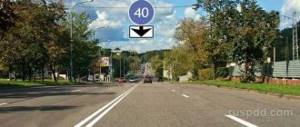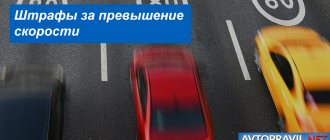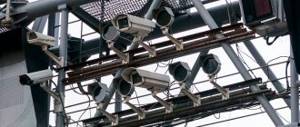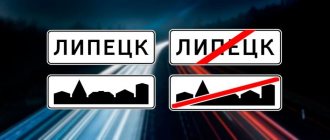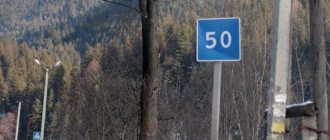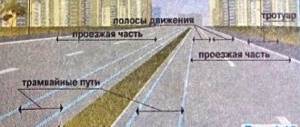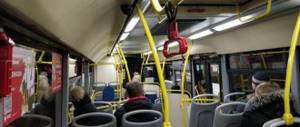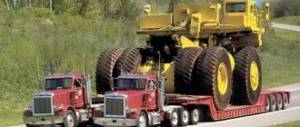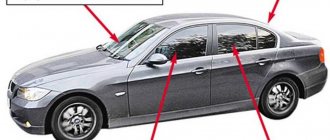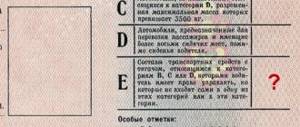Maximum speed outside the city
On motorways
The maximum permitted speed on the roads of the Russian Federation is currently 130 km/h . You can drive at this speed if two conditions are met simultaneously
- Sign 5.1 “Motorway” has been installed.
- Sign 3.24 “Maximum speed limit” is installed with a value of 130.
Note. This combination of road signs can be found on the roads extremely rarely. If you have come across similar highways, write about them in the comments to the article.
On ordinary roads
On regular country roads, the maximum permitted speed is:
| 90 km/h | for cars, category B trucks, motorcycles, intercity and small buses. |
| 70 km/h | for cars with trailers, category C trucks, and other buses. |
| 60 km/h | for trucks with people in the back and buses when transporting a group of children in an organized manner. |
| 50 km/h | when towing a motor vehicle. |
However, this does not mean that a passenger car outside the city can always drive at a speed of 90 km/h. There are numerous conditions under which the speed must be reduced and these will be discussed below.
Cancellation of non-penalized speeding +20 km/h. Last news
Outside cities, the speed limit will not be so limited:
- Cars or trucks (cat. B), motorcycles and small buses - 90 km/h;
- Passenger cars with trailers, trucks (cat. C), other buses – 70 km/h;
- Buses when transporting children, trucks with passengers (in the back) - 60 km/h;
- Cars towing vehicles – 50 km/h.
Fines for speeding in 2021 in Russia have remained at the same level. Although it’s not worth taking risks by breaking the rules, it’s better to move at an average speed.
Roads that allow the maximum speed of movement are called highways. Transport moves along them faster than usual:
- Motorcycles, cars and trucks (cat. B) – 110 km/h;
- Cars with trailers, buses and trucks (cat. C) – 90 km/h;
- Buses when transporting children, trucks with people (in the back) - 60 km/h;
- Cars towing vehicles – 50 km/h.
It is safe to drive on motorways because their surfaces are usually in excellent condition.
Driving a car with a trailer has a number of its own features. It is worth understanding that a trailer is, first of all, a vehicle that greatly influences the cars towing it. For this reason, vehicles with trailers are subject to the same speed limits as category C trucks.
A bus is a multi-passenger vehicle designed to transport passengers. The following standards apply to this type of transport:
| Kind of transport | Expressway (km/h) | Outside the city |
| Micro and intercity buses | 90 | 60 |
| Other buses | 90 | 70 |
| Vehicles transporting a group of children | 60 | 40 |
Regardless of the vehicle category, it is prohibited to drive faster than 20 km/h within residential areas.
A passenger car is the most common type of four-wheeled vehicle, which has a fairly short braking distance, unlike large cars. Therefore, the following restrictions were established for it:
| Route | Permissible norm, km/h |
| Motorway | 110 |
| Zagorodnaya | 90 |
| Urban | 60 |
Since there are large crowds of people in residential areas, the speedometer needle should not show more than 20 km/h within these areas.
With signs that reduce the permissible speed, everything seems to be clear: if we are driving in a city within the coverage area of the prohibitory sign “40”, then we can drive no more than 40, and not 60 km/h, since the road sign has priority.
We learned above that by this means local authorities can increase the permitted speed. For example, on a highway up to 110 km/h by installing the appropriate sign. And this is completely legal.
Limiting the maximum speed using a sign 3.24
Prohibitory sign 3.24 “Maximum speed limit” is one of the most popular signs on country roads:
3.24 "Maximum speed limit." It is prohibited to drive at a speed (km/h) exceeding that indicated on the sign.
The meaning of this sign depends on the number inscribed in the red circle.
For example, if the sign shows the number 70, then you can drive no faster than 70 km/h.
In most cases, the sign is used specifically to reduce the permitted speed .
However, sign 3.24 can also be used to increase the permitted speed. Clause 10.3 of the traffic rules:
Note. By decision of the owners or possessors of highways, an increase in the speed on sections of roads for certain types of vehicles may be allowed if road conditions provide for safe movement at a higher speed.
For example, let there be a sign on a country road with a limit of 90 km/h:
For passenger cars, this sign does not change anything. However, it applies to all types of vehicles. Therefore, for category C trucks, whose speed is normally limited to 70 km/h, this sign raises the maximum permitted speed to 90 km/h.
Stepped speed limit
Let's look at the features of installing 3.24 signs, which are unknown to most drivers. The point is that if a section of the road has a low speed limit, then the signs should be installed in steps of 20 km/h. This is regulated by the requirements of GOST R 52289-2004 (clause 5.4.22):
If a maximum speed is set on a given section that differs from the maximum permitted speed on the previous section by 20 km/h or more, a stepped speed limit is applied in increments of no more than 20 km/h by sequentially installing signs 3.24 at a distance of 100-150 m from each other. friend.
A stepped speed limit may not be applied in front of a populated area indicated by sign 5.23.1 or 5.23.2 if the visibility distance of the sign is more than 150 m.
Thus, when organizing repairs on country roads, a combination of signs “70 - 50 - 40” can be used and a separate sign “40” cannot be used. Otherwise, installing the sign is a violation of GOST requirements.
Speed and distance in figures and facts
Never rush. A skilled driver is, first of all, one who knows how to choose the speed in accordance with the road conditions. "Fast when possible, slow when necessary."
Now let's approach this topic practically. Regulations and restrictions on the speed limit in the traffic rules of the Republic of Kazakhstan are given not only in section Chapter 10 “Speed”, but are also given in other chapters that determine special traffic conditions, for example, passage through railway tracks, towing, transportation of people and goods, etc. .d. We will try to collect all this scattered information together - this will be a help for drivers and a training manual for those who are just preparing to become a driver. Let's start with the minimum number and then ascend.
And so: 8 km/h - if the speed of the vehicle according to the technical specifications is less than 8 km/h when passing through a railway crossing, it is permitted only with the agreement and permission of the head of the railway track.
20 km/h is the maximum speed for vehicles in residential areas.
30 km/h – In the area of sign 3.22 “Overtaking is prohibited”, overtaking of all vehicles is prohibited, except for single vehicles moving at a speed of less than 30 km/h.
– 3.21 overtaking is prohibited for trucks with a gross weight of more than 3.5 tons, except for single vehicles moving at a speed of less than 30 km/h.
40 km/h – On highways marked with sign 5.1, the movement of vehicles whose speed, according to their technical characteristics or their condition, is less than 40 km/h is prohibited. 9.5. Vehicles whose speed should not exceed 40 km/h for technical reasons cannot reach such a speed must move in the far right lane, except for cases of detour, overtaking, changing lanes, as well as for turning left, making a U-turn.
9.11. On roads outside the city, drivers of all vehicles whose speed should not exceed 40 km/h are required to maintain such a distance between their vehicle and the vehicle moving ahead so that vehicles overtaking them can easily change lanes to the previously occupied lane.
This rule does not apply during heavy traffic in an organized column.
50 km/h – The maximum permissible speed when towing motor vehicles.
60 km/h a) Maximum speed for all vehicles in built-up areas (indicated by sign 5.22 on a white background). b) The maximum permissible speed when transporting passengers in the back of a truck.
70 km/h – Maximum permissible speed outside the city
– trucks with a permissible maximum weight of more than 3.5 tons.
– passenger cars with trailers
– city and tourist buses, including those transporting groups of children.
90 km/h – Maximum speed – outside the city – cars with a permitted maximum speed of up to 3.5 tons, intercity buses, especially small buses. On highways - trucks with a gross weight of more than 3.5 tons, cars with trailers, city buses, tourist buses, including those transporting groups of children.
110 km/h – maximum permitted speed – on highways – for trucks with a maximum weight of no more than 3.5 tons. Intercity and minibuses.
In non-populated areas - cars and motorcycles.
140 km/h is the maximum permitted speed for cars and motorcycles on highways.
10.5 The driver is prohibited from:
– Exceed the maximum speed determined by the technical characteristics of the vehicle;
– Exceed the speed indicated on the “Speed Limit” identification sign installed on the vehicle.
– Obstruct other vehicles by driving unnecessarily at too low a speed.
– sharply unless necessary to prevent a traffic accident.
If the maximum speed exceeds the established technical specification, the vehicle may lose the necessary stability and controllability on the road. Parts of the engine and chassis may fail, or they may not be able to withstand the load of the tire.
By prohibiting movement unnecessarily at too low a speed, thereby interfering with other vehicles, the Rules mean that the vehicle is in good working order and there are no other factors preventing movement at the permitted speed.
Emergency braking in conditions may be unexpected for other drivers, so the Rules allow you to drive through a controlled intersection without resorting to emergency braking. At the same time, this requirement of the Rules does not prohibit drivers from using emergency braking in cases where it is necessary to prevent a traffic accident. The DRIVER must choose a distance such that in the event of sudden braking of the vehicle in front, a collision can be avoided. In the city it should be ½ the speed of movement, and outside the city - 1/1. Or speed 100 km/h distance 100 meters. Drivers, speed is a great advantage of a car; use this benefit correctly so that it does not turn into a detriment. Stay healthy and safe.
18 total today
Also interesting for you!
THREE RULES OF DRIVING SKILL
Car driving training
Using external lighting devices
Test yourself in matters of speed.
Legal page. To help students of the ABC Driver driving school
Learn to drive the real way. Driver training is making building blocks for...
← Previous post
Next entry →
Leave a comment Cancel reply
End of sign 3.24 coverage area
There are several conditions under which the meaning of road sign 3.24 is canceled.
End of maximum speed limit zone
The simplest case. The end of the limit is indicated by sign 3.25 “End of maximum speed limit zone”:
The end of the zone of all restrictions
The second situation is sign 3.31 “End of all restrictions zone” installed on the road:
Coverage area
Third option. Together with sign 3.24, plate 8.2.1 “Area of Operation” can be installed:
In this case, the speed limit applies only to that section of the road whose length is indicated on the sign (in the example - 100 meters).
Let's figure out how to determine the end of a dangerous section without leaving the car. This can be done by using a car odometer (a device for measuring the distance or mileage traveled by a car).
If you come across sign 3.24 with plate 8.2.1 on the road, then immediately look at the odometer and remember its current reading. Add to it the value indicated on plate 8.2.1. This will be the end of the dangerous area. After this, you should look at the odometer from time to time to determine where the restriction ends.
When calculating, it makes sense to leave a small margin of distance (100 meters). It’s better to drive slower a little longer than to get a traffic police fine for speeding.
Another sign 3.24
The fourth case - a new sign 3.24 “Maximum speed limit” was installed on the road. In this case, the speed limit set by the new sign applies.
Crossroads
The effect of sign 3.24 is interrupted when a car enters the intersection. It must be remembered that exits from adjacent territories, as well as intersections with field and forest roads not marked with appropriate signs, do not cancel the effect of sign 3.24.
The beginning and end of a settlement
The last situation is the presence on the road of signs indicating the beginning or end of a populated area. It is important to note that the effect of sign 3.24 is canceled only by signs 5.23.1, 5.23.2, 5.24.1, 5.24.2, 5.26:
Please note that sign 5.25 does not cancel the previously introduced speed limit:
The maximum speed limit is not canceled
In practice, when driving outside the city, you can come across signs 3.24, the effect of which is not canceled by anything . Their effect can extend tens of kilometers to the nearest populated area.
This state of affairs does not please drivers, but in the described case it is necessary to adhere to the speed indicated on the prohibiting sign.
Recommended driving speed
On country roads you can also find information sign 6.2 “Recommended speed”:
6.2 "Recommended speed". The speed at which it is recommended to drive on this section of the road. The sign's coverage area extends to the nearest intersection, and when sign 6.2 is used together with a warning sign, it is determined by the length of the dangerous area.
This sign does not oblige drivers to anything, so you can decide for yourself whether to follow its recommendations or not.
Minimum speed limit
The traffic rules provide a sign that limits the minimum speed:
4.6 "Minimum speed limit." Driving is only permitted at the specified speed or higher (km/h).
Moreover, the end of the coverage area of this sign, unlike sign 3.24, can be indicated only in one way - sign 4.7:
Note. If there is a “Minimum speed limit” sign, it is impossible to stop the car without violating traffic rules, i.e. it turns out that stopping and parking in the area covered by this sign is prohibited.
Entries to and exits from populated areas
Do not forget that the maximum speed of movement, in addition to sign 3.24, can also be limited by entrances to populated areas, which are indicated by the corresponding signs on a white background:
When entering even the smallest village marked with such a sign, you must reduce your speed to 60 km/h .
You can accelerate again to 90 km/h only after the car passes the sign indicating the end of the settlement:
Note. Signs indicating the beginning of a settlement are usually installed on the right side of the road, so it is quite difficult not to notice them. As for signs indicating the end of a populated area, they can be installed both to the right and to the left of the roadway. Therefore, it is not always possible to notice them.
Braking distance of a car depending on speed and other factors (table)
Every professional and competent driver must be able to apply braking and maneuvering skills in bad weather conditions, on slippery road surfaces, and in emergency driving situations.
According to the rules of the road, the driver must ensure, in accordance with the current road situation, the reduction in vehicle speed necessary for safety, up to its complete stop. Therefore, knowledge of effective braking techniques and the ability to apply them is the key to driver confidence in ensuring safety in emergency situations on the roads.
The stopping distance is the distance that the car will travel from the moment the driver detects the danger until it comes to a complete stop, and consists of two parts - the driver’s reaction time and the braking distance (see figure below).
STOPPING DISTANCE = REACTION TIME + BRAKING DISTANCE
Driver reaction time is the time from the moment the driver receives information until the start of a response action (control). For example, in the event of a sudden appearance of one or another obstacle (danger) on the road, it takes approximately 0.25 seconds for the driver to remove his foot from the throttle control pedal and transfer it to the brake pedal. The total reaction time, including the time to perceive the braking signal, can fluctuate between 0.45 and 5 seconds. - depending on various factors.
The braking distance of a car is the distance covered from the start of the brakes (braking) until the car comes to a complete stop.
For hydraulic brakes to operate (reach maximum fluid pressure in the drive, and then intensively brake the wheels) it takes from 0.1 to 0.2 seconds. During this time, the car travels a certain distance. The size of the braking distance covered by a car depends on the adhesion force of the car's tires to the road surface and the speed of movement. The braking distance is a square function of the speed. So, if the speed of the car increases by 3 times (from 20 to 60 km/h), then the braking distance increases by 9 times; if the speed increases by 5 times, the braking distance increases accordingly by 25 times.
Factors influencing braking distance and driver reaction time:
| Factors influencing driver reaction time | - Weather — Visibility conditions (poor visibility, night, or bright sun) — Driver’s condition (fatigue, intoxication) — Individual driver experience |
| Factors influencing the braking distance | — Serviceability of the brake system (obviously) — Tire condition (tread height, air pressure) — Manufacturer, brand and type of tires (winter, summer, Velcro) — Vehicle weights (car, truck, empty, loaded) — Availability of ABS and other modern auxiliary systems — Movement speed (one of the main factors) |
Car braking distance table
The table shows the approximate average braking distances on a horizontal section of the road for passenger cars, for different road surfaces and their conditions (dry, wet, snow, ice), at various speeds from 10 to 120 km/h.
| Type of road surface | Coating condition | Vehicle speed, km/h | |||||
| 10 | 20 | 30 | 40 | 50 | 60 | ||
| Vehicle braking distance, m | |||||||
| Asphalt concrete | Dry | 0.57—0.49 | 2.25—1.95 | 5—4.4 | 9—7.85 | 14.1—12.3 | 20.3—17.8 |
| Wet | 1.3—0.99 | 5.25—3.95 | 11.8—8.9 | 21—15.7 | 33—24.5 | 47.4—35.5 | |
| Crushed stone highway | Dry | 0.66—0.57 | 2.7—2.25 | 5.9—5 | 10.4—9 | 16.5—14 | 23.6—20.3 |
| Wet | 1.3—0.99 | 5.25—3.95 | 11.8—8.9 | 21—15.7 | 33—24.5 | 47.4—35.5 | |
| Stone ends | Dry | 0,99—0.66 | 3.15—2.7 | 7.1—5.9 | 12.5—10.4 | 19.7—16.5 | 28.4—23.6 |
| Wet | 1.3—1.1 | 5.25—4.5 | 11.8—10 | 21—18 | 33—28 | 47.4—40.5 | |
| Dirt road, clay | Dry | 0.99—0.66 | 3.15—2.7 | 7.1—5.9 | 12.5—10.7 | 19.7—16.5 | 28.4—23.6 |
| Wet | 1,97—1.3 | 7.85—3.95 | 17.6—8.8 | 31.4—15.7 | 49.4—24.5 | 70.6—35.5 | |
| Sand | Dry | 1.3—0.99 | 3.95—3.15 | 8.9—7.1 | 15.7—12.5 | 24.5—19.7 | 35.5—28.4 |
| Wet | 0.99—0,66 | 3.15—2.17 | 7,1—5.9 | 12.5—10.4 | 19.7—16.5 | 28.4—23.6 | |
| Compacted slag | Dry | 0.99—0.66 | 3.15—2.7 | 7.1—5.9 | 12.5—10.4 | 19.7—16.5 | 28.4—23.6 |
| Compacted snow | — | 1.97—1.3 | 7.85—5.25 | 17.6—11.8 | 31.4—21 | 49.4—33 | 70.6—47.4 |
| Icy road | — | 4.9—3.9 | 19.7—15.7 | 44—35.4 | 79—63 | 123—98 | 177—142 |
| Type of road surface | Coating condition | Vehicle speed, km/h | |||||
| 70 | 80 | 90 | 100 | 110 | 120 | ||
| Vehicle braking distance, m | |||||||
| Asphalt concrete | Dry | 25.6—24.2 | 37—31.5 | 45.7—40 | 56.3—49.3 | 63.2—59,9 | 81.4—71.4 |
| Wet | 64.5—48.5 | 83.8—63 | 106—80 | 131.5—97.5 | 158.5—118.5 | 188.5—141.5 | |
| Crushed stone highway | Dry | 32.2—27.6 | 42—36 | 53.3—45.5 | 65.6—56.4 | 79.5—67 | 94.5—81 |
| Wet | 64.5—43.5 | 83.8—63 | 106—80 | 131.5—97.5 | 158.5—118.5 | 188.5—141.5 | |
| Stone ends | Dry | 38.6—32.2 | 50.3—42 | 64—53.3 | 78.7—65.6 | 95—79.5 | 113—94.5 |
| Wet | 64.4—55.2 | 83.8—71.7 | 106—91.3 | 131.5—113 | 158.5—136 | 188.5—161,5 | |
| Dirt road, clay | Dry | 38.6—32.2 | 50.3—42 | 64—53.3 | 78.7—65.6 | 95—79.5 | 113—94.5 |
| Wet | 97—48.5 | 125.5—63 | 159—80 | 197—97.5 | 237—118.5 | 284—141.5 | |
| Sand | Dry | 48.5—38.6 | 63—50.3 | 80—64 | 97.5—78.7 | 111.5—95 | 141.5—113 |
| Wet | 38.6—32.2 | 50.3—42 | 64—53.3 | 78.7—65 6 | 95—79.5 | 113—94.5 | |
| Compacted slag | Dry | 38.6—32.2 | 50.3—42 | 64—53.3 | 73.7—65.6 | 95—79.5 | 113—94.5 |
| Compacted snow | — | 97—64,5 | 125.5—83.8 | 159—106 | 197—78.7 | 237—158.5 | 284—183.5 |
| Icy road | — | 240—193 | 315—252 | 398—316 | 494—394 | 593—475 | 706—575 |
The graph below shows the braking distance of a car on winter tires of different manufacturers and brands, on wet and dry asphalt.
Fines for speeding on the highway
A detailed table of fines for speeding is given in a separate article:
Table of fines for speeding in 2021
Let me remind you that in 2021, fines are imposed for exceeding the speed limit by 20 km/h or more. The size of the fine directly depends on how much the speed is exceeded. The minimum penalty is 500 rubles, the maximum is deprivation of rights for 12 months.
Permissible speed limit in 2021
The amount of the fine for speeding is regulated by Article 12.9 of the Code of Administrative Offenses of the Russian Federation. The regulatory legal act was amended on 04/04/17.
If a citizen violates the speed limit, the following fines will be applied to him:
- 500 rubles if the permissible speed was exceeded by 20-40 km/h. The incident will be investigated by the internal affairs bodies.
- 1-1.5 thousand rubles, if the driver was driving 40-60 km/h faster than the established norm. The decision to impose a fine is made by the State Traffic Safety Inspectorate.
- 2-2.5 thousand rubles. or suspension from driving for up to 0.5 years if the driver exceeded the speed by 60-80 km/h. The case can be considered in court or by representatives of the traffic police.
- 5 thousand rubles if the speed was exceeded by more than 80 km per hour. The punishment may be replaced by deprivation of rights. A person will not be able to drive a vehicle for 0.5 years.
If a person is caught violating the law again, the punishment becomes more severe. In the case where the speed limit was 40-60 kilometers per hour, the fine will increase to 2.5 thousand rubles. If a person repeatedly drives more than 60 km/h faster than the norm, he will be disqualified from driving for one year. If the violation was recorded by cameras, the driver will get off with a fine for speeding in the amount of 5 thousand rubles.
The process of recognizing speeding as repeated is regulated by Article 4.6 of the Code of Administrative Offenses of the Russian Federation. It states that the person subject to the penalty will be considered subject to it after the order comes into force. The term will end in a year. This means that the violation was committed again if the person violates the speed limit again within 12 months from the date of the decision.
It comes into force:
- 10 days after the document was served on the violator, or after filing a complaint about the legality of the previously issued decision;
- after 1 day, if a complaint against administrative arrest was filed;
- after 60 days, if a person complained about a previously imposed fine.
It is considered that a citizen has committed a repeated offense if he exceeds the speed limit the next day after the decision on a fine for a similar violation comes into force.
The speed limit is determined in accordance with the provisions of the traffic rules. Chapter 10 is devoted to issues related to the concept. the above collection of normative legal acts. The speed of movement that is allowed in a particular area is influenced by a whole list of factors.
The list includes:
- type of road;
- location of the road surface;
- type of vehicle;
- the purpose for which the citizen went on a car trip.
To clearly understand what speed is allowed in a given situation, you should familiarize yourself with the table below. The specified values may be exceeded if appropriate signs are present. In this situation, no fine will be issued. You cannot increase the speed above the values that apply for driving on the motorway.
Table of fines for speeding in 2021:
| Maximum speed allowed for vehicles weighing up to 3500 kg (in kilometers per hour) | ||||
| In the city | Residential areas | Highways | Other routes outside populated areas | |
| The car drives on its own | 60 | 20 | 110 | 90 |
| The car is towing another vehicle | 50 | 50 | ||
| Trailer being towed | 60 | 90 | 70 | |
| Permissible speed limit in km/h for vehicles weighing up to 3500 kg. | ||||
| Settlements | Roads in courtyards or residential areas | Trails | Other roads located outside cities and villages | |
| The car moves independently | 60 | 20 | 110 | 90 |
| A car is towing another vehicle | 50 | 50 | ||
| Trailer being towed | 60 | 90 | 70 | |
| Limits in km/h for vehicles weighing more than 3500 kg. | ||||
| Cities, villages, villages, etc. | Traffic in residential areas | Highways | Other roads outside populated areas | |
| The car moves on its own | 60 | 20 | 90 | 70 |
| A car is towing another vehicle | 50 | 50 | ||
| There are passengers in the back | 60 | 60 | ||
| The car is moving with a trailer | 60 | 90 | 70 | |
| Established limits in km/h for intercity buses with a small number of seats and motorcycles | ||||
| Settlements | Yards and other residential areas | Moving along the highway | Other roads outside populated areas | |
| Standard ride | 60 | 20 | 90 | |
| The car is towing another vehicle | 50 | 50 | ||
| Children are transported in vehicles | 60 | 60 | ||
| Maximum speed in km/h for other vehicles for the transport of persons | ||||
| Settlements | Yards and other residential areas | Driving on the motorway | Other roads outside populated areas | |
| Self-driving vehicle | 60 | 20 | 90 | 70 |
| The car is towing another vehicle | 50 | 50 | ||
| Transportation of a group of minors | 60 | 60 | ||
If the vehicle is used to transport special loads, the vehicle is subject to a special speed limit. Exceeding it will result in a fine. The speed of the vehicle is agreed upon during the delivery transaction. Exceeding the limit will be considered a violation. Regardless of the speed limit, at a zebra crossing the driver must stop and let the pedestrian pass.
To apply a fine for exceeding the speed limit by 20 km/h, traffic police officers are required to measure it. Radars are used for this. However, there are a number of rules that traffic police officers must follow when using such equipment.
Traffic officers wishing to issue a fine for speeding must:
- Demonstrate the speed indicators that appear on the radar.
- Prove that the data relates specifically to the stopped car (photo recording has been completed).
- Provide documents confirming that the equipment meets the requirements.
- Issue a fine for speeding if the motorist admits to violating traffic rules.
A motorist is not required to agree with the charge of speeding and the fine issued. If the driver claims that he did not violate the rules, the traffic inspector must draw up a report. It will be transferred to the court or the State Traffic Safety Inspectorate.
If a person is faced with a disagreement regarding a speeding ticket, experts advise seeking advice from a professional lawyer.
The driver has 10 days to file a complaint against the decision. If a person fails to apply within the established time limit, he will have to pay a fine for speeding. The assignment of a monetary penalty and determination of its size will be carried out in accordance with the provisions of Article 12.9 of the Code of Administrative Offenses of the Russian Federation.
Fines for driving too slowly
The Code of Administrative Offenses does not provide for a separate article containing punishment for driving at too low a speed (if there is a 4.6 sign). However, for this violation the driver may be punished under Part 1 of Article 12.16 for failure to comply with the requirements of road signs.
For too low a speed, you can receive a warning or a fine of 500 rubles .
Note. In this case, it does not matter how much the car’s speed was less than the value indicated on the sign. The fine will be the same.
Good luck on the roads!
